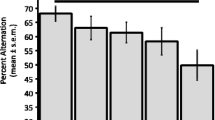Abstract
Experiments in mice tested previous evidence that activation of cholinergic systems promotes catalepsy and that cholinergic mechanisms need to be intact for full expression of neuroleptic-induced catalepsy. Large doses of the cholinomimetic, pilocarpine, could induce catalepsy when peripheral cholinergic receptors were blocked. Low doses of pilocarpine caused a pronounced enhancement of the catalepsy that was induced by the dopaminergic blocker, haloperidol. A muscarinic receptor blocker, atropine, disrupted haloperidol-induced catalepsy. Intracranial injection of an acetylcholine-synthesis inhibitor, hemicholinium, prevented the catalepsy that is usually induced by haloperidol. These findings suggest the hypothesis that the catalepsy that is produced by neuroleptics such as haloperidol is actually mediated by intrinsic central cholinergic systems. Alternatively, activation of central cholinergic systems could promote catalepsy by suppression of dopaminergic systems.
Similar content being viewed by others
References
Amir S, Brown ZW, Amit Z, Ornstein K (1981) Body pinch induces long-lasting cataleptic-like immobility in mice: Behavioral characterization and the effect of naloxone. Life Sci 28:1189–1194
Chaillet, P, Marcais-Collado H, Costentin J (1983) Catatonic or hypotonic immobility induced in mice by intracerebroventricular injection of Mu or Kappa opioid receptor agonists as well as enkephalins or inhibitors of their degradation. Life Sci 33:2105–2111
Freeman JJ, Kosh JW, Parrish JS (1982) Peripheral toxicity of hemicholinium-3 in mice. Br J Pharmacol 77:239–244
Gallup GG Jr (1977) Tonic immobility: The role of fear and predation. Psychol Rec 27:41–61
Haley TJ, McCormick WG (1957) Pharmacological effects produced by intracerebral injection of drugs in the conscious mouse. Br J Pharmacol 12:12–15
Kameyama T, Ukai M (1983) Multi-dimensional analyses of behavior in mice treated with morphine, endorphins and (destyrosines)-gamma-endorphin. Pharmacol Biochem Behav 19:671–677
Klemm WR (1977) Identity of sensory and motor systems that are critical to the immobility reflex (“animal hypnosis”). Psychol Rec 27:145–159
Klemm WR (1983a) Experimental catalepsy: Influences of cholinergic transmission in restraint-induced catalepsy. Experientia 39:228–230
Klemm WR (1983b) Cholinergic-dopaminergic interactions in experimental catalepsy. Psychopharmacology 81:24–27
Nemeroff CB, Bissette G, Prange AJ Jr, Loosen PT, Barlow S, Lipton M (1977) Neurotensin: Central nervous system effects of a hypothalamic peptide. Brain Res 128:485–496
SAS User's Guide (1982) SAS Institute, Cary, NC
Shaw GG (1974) Some shortcomings of direct intraventricular injections in mice. Br J Pharmacol 50:603–605
Smith GW, Klemm WR (1977) The fear hypothesis revisited: Other variables affecting duration of the immobility reflex (animal hypnosis). Behav Biol 19:76–86
Zetler G (1971) Pharmacological differentiation of “nicotinic” and “muscarinic” catalepsy. Neuropharmacology 10:289–296
Author information
Authors and Affiliations
Rights and permissions
About this article
Cite this article
Klemm, W.R. Evidence for a cholinergic role in haloperidol-induced catalepsy. Psychopharmacology 85, 139–142 (1985). https://doi.org/10.1007/BF00428402
Received:
Accepted:
Issue Date:
DOI: https://doi.org/10.1007/BF00428402




